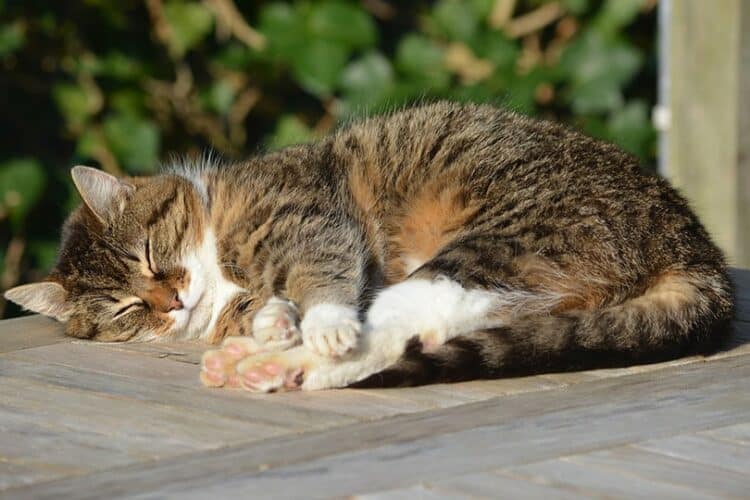It’s no secret that our furry canine friends love their siesta. In fact, the average cat spends about 70% of its life sleeping and much of the remaining 30% getting into all sorts of mischief. The predisposition for cats to snooze is embedded in their DNA. Cats are literally born to sleep!
Once you get past how adorable cats look while sleeping, you’ll notice their peculiar sleeping behavior. Cats sleep anywhere and have almost uncountable sleeping positions. Here are some of the most common sleeping positions every cat owner should know.
Click to Jump Ahead:
The 18 Most Common Cat Sleeping Positions
Cats are inherently solitary, and it’s no surprise they like sleeping by themselves in a comfortable space. Sometimes they might cuddle with their own species or with other friendly pets. Here are a few solitary sleeping positions and others that include their furry counterparts.
The 13 Healthy Sleeping Positions
1. Curled Into a Ball
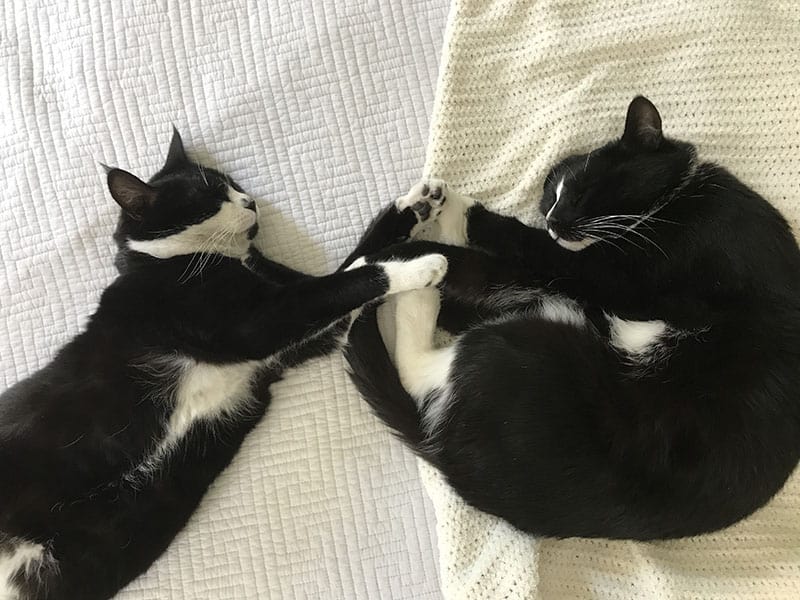
Cats love to curl up into furry balls before drifting into dreamland. This curled-up position, popularly known as the crescent, is a staple for most cats. This position helps cats retain as much heat from the body for added warmth. It also protects the cat’s sensitive parts, like its stomach and internal organs.
This sleeping position comes instinctively with cats, especially wild ones. It’s the safest position for them to get some shut-eye.
2. The Bread Loaf Position
This is another common sleeping position where the cat sits upright and tucks the front paws under its body, and drifts into sleep. It’s called the loaf position because the cat somewhat resembles a loaf of bread.
Cats don’t usually sleep in the loaf position for deep sleep. This is usually a quick snooze that takes no longer than five minutes. Cats still maintain considerable alertness in this position and can easily scurry away should they sense an external threat.
3. Side Sleeping
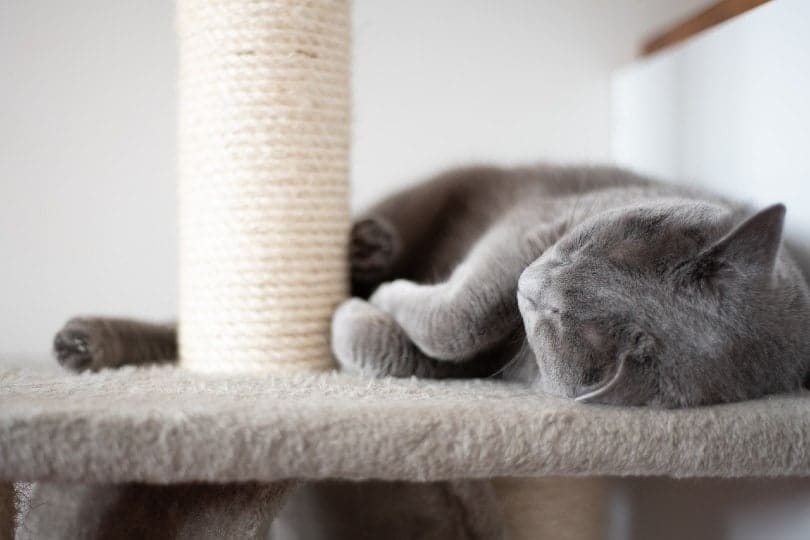
Cats also love to sleep on the side with their legs stretched out. Your cat sleeping on its side next to or near you signifies trust. Lying on its side exposes all its vital organs to external threats. Side sleeping means the cat is super comfortable around you.
However, sleeping on its side also means the cat can spring into a sprint with a finger snap. The cat can scamper to safety before the threat gets hold of it.
4. The Monorail
The monorail is when cats sleep on narrow surfaces, with some parts of their body dangling off the surface. This is a comfortable sleeping position that we can trace back to the cat’s ancestors dangling on branches while catching some quality sleep. It’s also a safe sleeping position since cats can jump to safety should they feel threatened.
5. The Filler
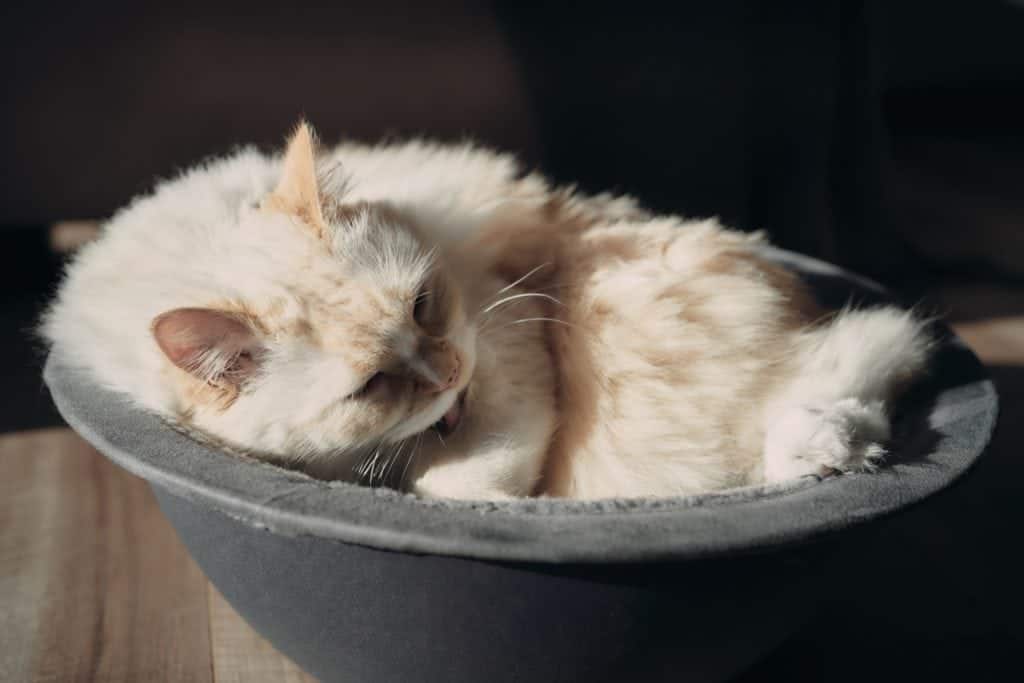
Cats can’t resist hopping into an open container to sleep snugly inside it. If you leave your mixing bowl or shoe box unattended, you’ll likely find an adorable cuddly feline enjoying a short nap.
Cats usually “melt” into containers to sleep if they feel a threatening presence in their space. The containers are an excellent hiding spot where they can enjoy a quick snooze without worrying about anything harming them. However, sleeping in this position makes it hard for them to scamper to safety should they be caught unawares.
6. Sitting Upright
If you’re lucky, you might get your cat sleeping in an upright seated position. This isn’t too common because it’s an unnatural position and also exposes their sensitive bellies. However, most cats sleep in the position after they accidentally drift off into sleep while grooming their bellies. It’s an alert position, allowing them to dart off should something startle them.
7. On Their Backs

Cats rarely sleep on their back because doing so exposes their sensitive tummies and other vital organs. However, if you’re lucky, you might spot your cat on its back with its front legs resting on the belly or stretched out.
Sleeping on its back means the cat feels comfortable and secure around your presence. Still, resist the urge to scratch its belly while it sleeps on its back. It might instinctively attack and give you a quick nip or scratch you.
8. The Superman Pose
This is the go-to position for cats when lying on soft, fuzzy surfaces. The cats stretch their front legs and lie bellies flat on the surface. The hind legs are also extended outwards, allowing the belly to feel the softness of the surface it rests on.
The superman pose is a favorite for cats, protecting their sensitive bellies. It also allows them to spring into a sprint in case of an external threat. Lying on soft material on their bellies also allows them to conserve body heat. The cats may assume this sleeping position on tiles and wooden surfaces in hot weather.
9. The Pretzel

The pretzel sleeping position can best be described as haphazard. It’s when your cat sleeps with its arms and head facing all directions, making it look like a furry pretzel. Surprisingly, the pretzel, or contortionist, position is quite intentional.
With parts of the cat’s body facing different directions, it’s hard for predators to predict its next move. It also gives the cats a complete feel of the environment because its limbs and face are all over the place.
10. The Kitty Pile
If you own a kindle of kittens, you’ve probably seen them bundle up together to sleep. This sleeping position, known as the cat pile, allows for maximum warmth and security. Sometimes the kittens pile with their mom to get some quality sleep and wake up to a generous helping of mom’s milk.
Cats sleeping together shows that they enjoy a healthy social bond. It’s a sign that they trust each other and feel comfortable around themselves. Sometimes the kitty pile transcends species, so don’t be surprised to see your cat piled up with your dog. This is always a good sign.
11. Tucked In
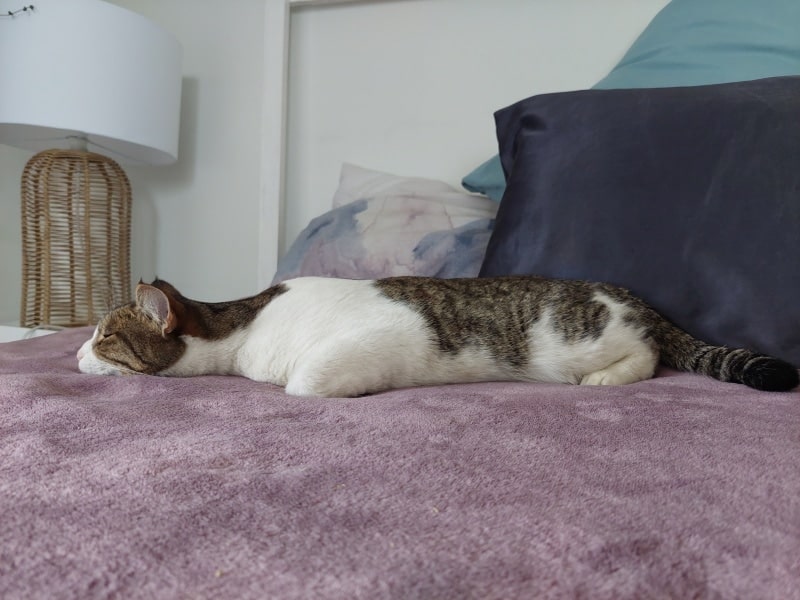
Cats sometimes beat their owners to their own beds. It’s not uncommon to find your furry feline friend tucked inside your comforter, especially if you’re used to snuggling up with it at night.
The tucked-in sleeping position allows the cat to maximize their body heat by curling up inside bedding. It’s also a safe position since they can hide from threats under the blankets. Plus, it presents the perfect opportunity for you to cuddle with your furry friend.
12. Paws Over the Eyes
Cats sleeping with their tiny paws over their eyes is the epitome of beauty. The paws provide insulation from the cold and protect the eyes from harsh light and air pollutants like dust and pollen.
Be sure to take a quick snapshot of your furry friend if you catch them sleeping in this position and post it on social media to share the cuteness.
13. Sleeping With Its Tongue Out
A cat sleeping with its tongue out doesn’t mean to tease you. This adorable sleeping position shows your cat is comfortable and content. Sometimes cats get so comfortable while sleeping that they relax their jaws, and the tongue comes slipping out.
The 5 Unwell Cat Sleeping Positions
Some sleeping positions may indicate that your cat may be unhealthy. Some of them include the following.
1. Sleeping Next to the Water Bowl

Some cats might find the spot next to the water bowl a comfortable place to sleep. However, sometimes the cat might rest near the water bowl because it’s thirsty and dehydrated. Gently pinch the skin between its shoulders and check whether it reverts to its normal position quickly. If it doesn’t, your cat is likely dehydrated and needs water.
This dehydration could be a sign of a more severe underlying condition. Your cat could have kidney disease if this dehydration is coupled with frequent urination, weight loss, and bloody urine. Excessive urination and visible lethargy could be a sign of diabetes. Take your cat to the vet if you notice any of these symptoms.
2. Sleeping With Its Face Down
Cats sometimes sleep with their faces if they need privacy or want to keep their faces warm. However, when your sociable cat starts to sleep with its face down during warm weather, you should be worried. This is especially true if it presses its face down while in the loaf position.
- Lethargy
- Decreased appetite
- Uncoordinated walking
- Seizures
- Drooling
The above symptoms could indicate anything from liver poisoning to brain tumors. Early diagnosis and treatment by a licensed veterinarian could save your precious cat’s life.
3. Sleeping in the Same Position
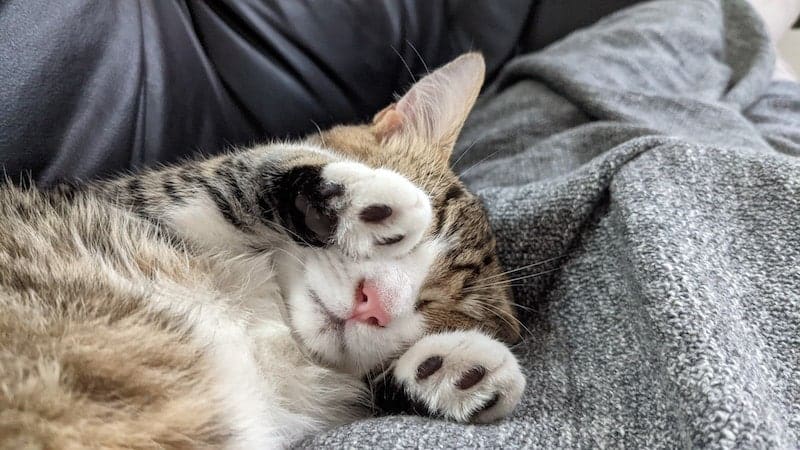
Have you noticed your cat sleeping in the same position for too long? Cats have a sleep cycle of about 104 minutes. They might wake up in between or after the cycle to change positions or find a new sleeping spot. Cats sleeping for too long in the same position could indicate a problem.
An unhealthy cat may be too weak to change positions and also sleep much longer than it usually does. If so, check for other symptoms of illness and contact a licensed vet for advice on ensuring your cat’s health.
4. Sleeping While Hidden Away
Cats are solitary by nature, and it’s normal for them to seek some peace and quiet away from open spaces to get some sleep. However, if your cat completely avoids sleeping with you or in the open, then something might be wrong.
Injured or unwell cats usually isolate themselves until they feel better. Your cat hiding away to sleep is a sign that you should call the vet.
5. Eyes Half Open
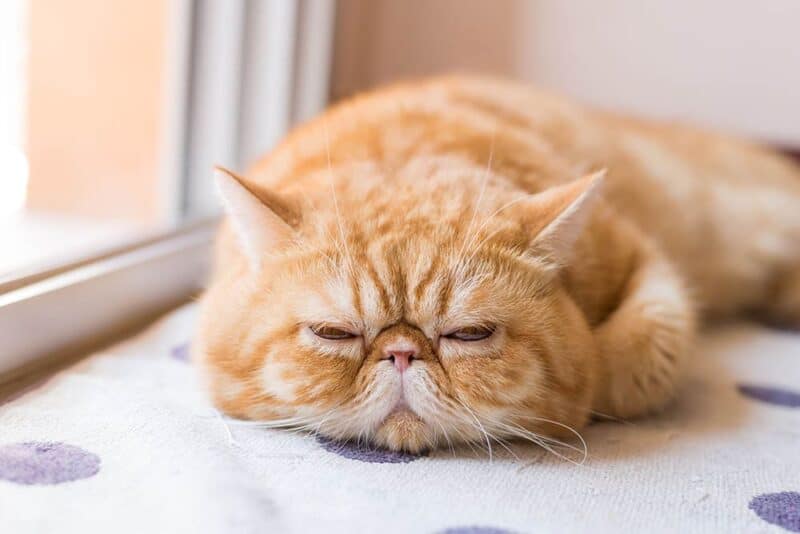
Unlike humans, cats can sleep with half their eyes open. Cats have a third eyelid known as the nictitating membrane. This eyelid protects the eye from foreign objects and also keeps it moist. When felines sleep with their eyes partially open, they expose this membrane.
While cats sleeping with half their eyes open is normal, some symptoms coupled with this behavior might indicate health issues. They include:
- Swollen eyes
- Squinting
- Frequent eye-pawing
Your cat could have a foreign body trapped in its eye or a blocked tear duct. Use sterile eye wash or tap water to dislodge the foreign object from your cat’s eye. Visit the vet for more severe health complications.
Last Thoughts
Sufficient sleep is imperative to a healthy and happy cat. Cats need sleep to conserve energy and recharge. It’s your responsibility as a cat parent to ensure a safe, comfortable, and conducive space for your cat to sleep.
Consider investing in a high-quality cat bed or scooching for your cat to share the bed or sofa with you. Don’t forget to keep an eye out for any signs of illnesses like irregular sleeping patterns and positions. A licensed veterinarian will help address any health issues with your cat for a healthy feline.
Featured Image Credit: Ben Kerckx, Pixabay


